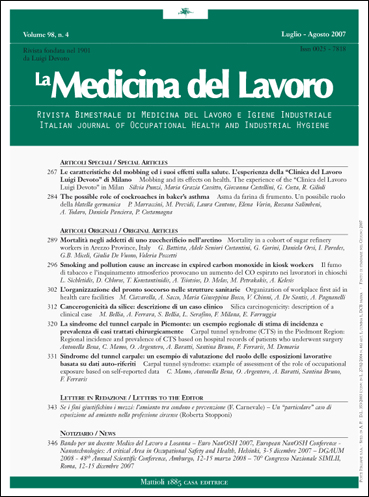Sindrome del tunnel carpale: un esempio di valutazione del ruolo delle esposizioni lavorative basata su dati auto-riferiti / Carpal tunnel syndrome: example of assessment of the role of occupational exposure based on self-reported data
Contenuto principale dell'articolo
Keywords
Carpal tunnel syndrome, exposure assessment, self-reported data
Abstract
La prevalenza di sindrome del tunnel carpale (STC) nella popolazione generale, stimata sulla base dei casi sottoposti ad intervento, tende ad aumentare in Italia, ma rimane argomento di dibattito quale quota di tale prevalenza sia legata ad esposizioni a fattori lavorativi ergonomici o psicosociali. Il Piemonte è tra le regioni con il più alto numero di malattie muscolo-scheletriche da causa lavorativa denunciate in Italia. Il presente studio ha provato a stimare, attraverso dati auto-riferiti, la quota di casi di STC attribuibili all’attività lavorativa. Per la rilevazione si è utilizzato un questionario, compilato tramite intervista. Si sono raccolti dati sull’anamnesi patologica, le esposizioni lavorative, nonché su potenziali fattori di rischio non occupazionali. Sono entrati in studio pazienti di età 15-65 anni, operati presso le strutture in studio, nel periodo giugno 2003-novembre 2004. Tre medici del lavoro hanno valutato le risposte al questionario, attribuendo ad ogni caso un giudizio di probabilità di eziologia professionale. Sono stati intervistati 260 pazienti (per il 74% donne), di età media 48,4 anni. Il 71% dei soggetti ha riferito una patologia bilaterale. Per 184 i pazienti vi era un possibile nesso temporale tra un’attività lavorativa considerata a rischio e l’insorgenza della malattia. Per 66 soggetti, rappresentanti il 26% di tutti i casi intervistati, si è ipotizzata una eziologia professionale con una probabilità considerata alta. Il grado di concordanza raggiunto dai medici nelle valutazioni è risultato accettabile. Pur tenendo conto dei limiti dello studio, il numero di casi attribuibili alla professione stimati in base a questo studio risulterebbe di molto superiore al numero di denunce di malattia professionale giunte all’INAIL, rilevando un problema di sottonotifica nella realtà italiana.
Carpal tunnel syndrome: example of assessment of the role of occupational exposure based on self-reported data
Background: The prevalence of surgical cases of carpal tunnel syndrome (CTS) tends to increase in the general population in Italy. Nevertheless, it is still unclear what percentage of CTS is attributable to occupational exposure, to ergonomic or psychosocial factors. Moreover, the problem of obtaining a reliable definition of occupational exposure in the absence of direct observation and measurement in the workplace remains unsolved. Piedmont (north-western Italy) is one of the Italian regions with the highest number of musculoskeletal disorders recognized and compensated as work-related. The aim of this study was to estimate the proportion of work-related CTS surgical cases, based on self-reported exposure data. Methods: An interview-based questionnaire included items on medical history, workplace exposures and non-occupational risk factors for CTS. The study was carried out between June 2003 and November 2004. A total of 260 adult patients (aged 18-65 years) were interviewed. An evaluation of the questionnaires was made by 3 occupational physicians, assigning every patient a probability score of occupational aetiology. Seventy-four per cent of the sample were female; the mean age was 48.4 years. Results: Seventy-one percent of the patients reported bilateral CTS. Occupational exposure preceded the onset of CTS symptoms for 184 patients. The probability that CTS was work-related was estimated as high for 66 patients (26% of the sample). Agreement among examiners, evaluated using the kappa statistic, was good. Conclusions: Despite the limitations of the study, the number of cases attributable to occupation was much higher than the number of diseases reported to INAIL (National Institute for the Insurance of Industrial Accidents), which suggests that there is substantial under-notification in Italy.
Carpal tunnel syndrome: example of assessment of the role of occupational exposure based on self-reported data
Background: The prevalence of surgical cases of carpal tunnel syndrome (CTS) tends to increase in the general population in Italy. Nevertheless, it is still unclear what percentage of CTS is attributable to occupational exposure, to ergonomic or psychosocial factors. Moreover, the problem of obtaining a reliable definition of occupational exposure in the absence of direct observation and measurement in the workplace remains unsolved. Piedmont (north-western Italy) is one of the Italian regions with the highest number of musculoskeletal disorders recognized and compensated as work-related. The aim of this study was to estimate the proportion of work-related CTS surgical cases, based on self-reported exposure data. Methods: An interview-based questionnaire included items on medical history, workplace exposures and non-occupational risk factors for CTS. The study was carried out between June 2003 and November 2004. A total of 260 adult patients (aged 18-65 years) were interviewed. An evaluation of the questionnaires was made by 3 occupational physicians, assigning every patient a probability score of occupational aetiology. Seventy-four per cent of the sample were female; the mean age was 48.4 years. Results: Seventy-one percent of the patients reported bilateral CTS. Occupational exposure preceded the onset of CTS symptoms for 184 patients. The probability that CTS was work-related was estimated as high for 66 patients (26% of the sample). Agreement among examiners, evaluated using the kappa statistic, was good. Conclusions: Despite the limitations of the study, the number of cases attributable to occupation was much higher than the number of diseases reported to INAIL (National Institute for the Insurance of Industrial Accidents), which suggests that there is substantial under-notification in Italy.






